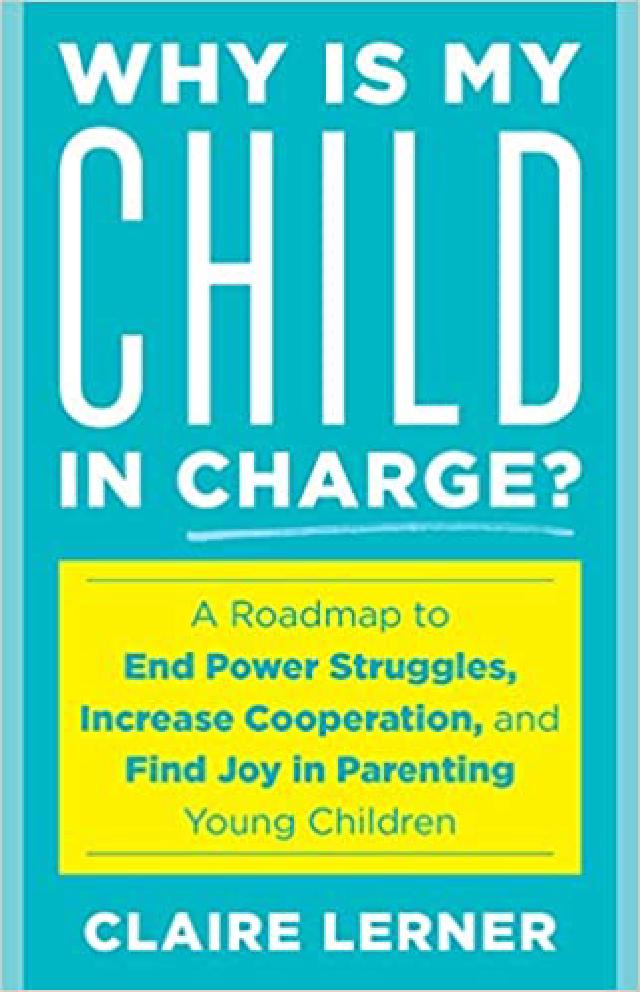Every homeschooler (and any parent!) should read this excellent book from Claire Lerner: “Why is my Child in Charge?”

The foundation of the book is learning to correct the faulty mindsets of parenting. Lerner lists the mindsets that are commonly (but wrongfully) believed:
1.My child is misbehaving on purpose. He should be able to accept limits and exhibit greater self-control.
2.When my child tries to get her way, she is being manipulative.
3.I can control and change my child’s feelings and behavior.
4.Experiencing difficult emotions, such as sadness, fear, and anger, is harmful to my child.
5.It is mean and rejecting not to always give my child what he says he wants and needs. The tantrums that ensue when he doesn’t get what he wants are detrimental to him.
6.Experiencing failure is harmful for my child.
7.Providing children clear directions and expectations is being harsh and dictatorial.
8.My child harbors malicious intent when she is aggressive with her words and actions.
Throughout the book, Lerner reminds parents to adjust their mindsets. Lerner suggests these mindsets are more correct:
“You need to see that your children aren’t acting out (misbehaving) on purpose; that they don’t have the ability to control their impulses or manage life’s stressors effectively or efficiently yet; that they are driven to go for what they want and aren’t being manipulative but strategic; that feelings are not right or wrong, good or bad—that a full range of emotions is part of being human; that tantrums aren’t inherently harmful to children; and that your child is way more competent than you may think he is. He can learn to cope with not being with you every waking (or sleeping!) second and not getting everything he wants, when he wants it. He can learn to muscle through a challenging task and adapt to changes in his world.”
Lerner explains that changing the parental mindset will decrease our reactivity as a parent. “Having appropriate expectations is critical because the meaning you assign to your child’s behavior influences how you react.”
Lerner empowers parents to assert authority appropriately. “Kids have parents for a reason; they need you to be in charge. Don’t fear your power. It is possible to be a strong, trusted authority figure while maintaining a loving connection with your child.” Children rely on parents to be the loving leader they need.
One of the important jobs of a parent is to set the limits that keep the child safe. A key take away from this book is identifying the difference between a direction and a choice. A choice is something the child can pick (yogurt or apples for a snack). A direction is something that has to be done (buckling the seatbelt in the car). Lerner cautions parents to stop communicating directions as questions. This makes them seem optional.
Lerner addresses techniques to avoid any power struggle. She reminds us, “when you focus your efforts on trying to make your child change his behavior, you actually put him in the driver’s seat. When you are in the position of trying to convince your child to cooperate with a direction or agree to a limit, you are actually ceding control of the situation to him.”
We can’t directly control the child. “the more you make it your goal to control your child—to get her to do something—the more she is in charge. Her behavior determines the outcome of the situation.”
Lerner teaches parents to create a plan that enables the goal to be met without depending on the child’s compliance. “One habit that can be helpful to get into is to always start by asking yourself what you do and don’t control in the situation at hand. This can prevent you from falling into the abyss of focusing on trying to change your child, and instead focus on changing your approach.”
“Focusing on the fact that your child is the decider and you are just implementing the consequences of his choices also makes children feel more in control and less defiant.”
Why every homeschooler should read this book: so they can begin to decrease the power struggles in their home. “My child won’t listen to me!” is one of the most common arguments I have heard about why people give up (or won’t even try) homeschooling. This book can help parents realize what they can do differently.